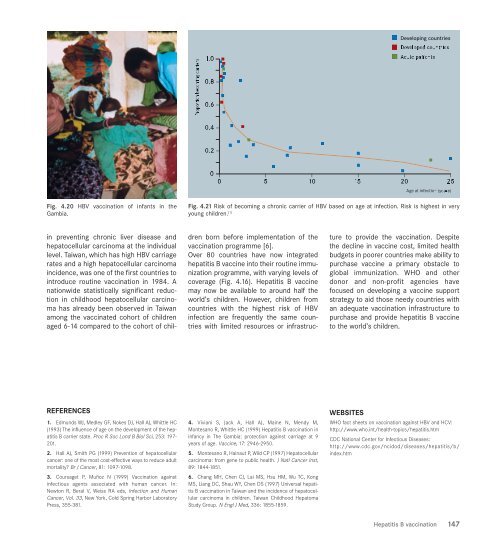world cancer report - iarc
world cancer report - iarc
world cancer report - iarc
Create successful ePaper yourself
Turn your PDF publications into a flip-book with our unique Google optimized e-Paper software.
Fig. 4.20 HBV vaccination of infants in the<br />
Gambia.<br />
in preventing chronic liver disease and<br />
hepatocellular carcinoma at the individual<br />
level. Taiwan, which has high HBV carriage<br />
rates and a high hepatocellular carcinoma<br />
incidence, was one of the first countries to<br />
introduce routine vaccination in 1984. A<br />
nationwide statistically significant reduction<br />
in childhood hepatocellular carcinoma<br />
has already been observed in Taiwan<br />
among the vaccinated cohort of children<br />
aged 6-14 compared to the cohort of chil-<br />
REFERENCES<br />
1. Edmunds WJ, Medley GF, Nokes DJ, Hall AJ, Whittle HC<br />
(1993) The influence of age on the development of the hepatitis<br />
B carrier state. Proc R Soc Lond B Biol Sci, 253: 197-<br />
201.<br />
2. Hall AJ, Smith PG (1999) Prevention of hepatocellular<br />
<strong>cancer</strong>: one of the most cost-effective ways to reduce adult<br />
mortality? Br J Cancer, 81: 1097-1098.<br />
3. Coursaget P, Muñoz N (1999) Vaccination against<br />
infectious agents associated with human <strong>cancer</strong>. In:<br />
Newton R, Beral V, Weiss RA eds, Infection and Human<br />
Cancer, Vol. 33, New York, Cold Spring Harbor Laboratory<br />
Press, 355-381.<br />
Fig. 4.21 Risk of becoming a chronic carrier of HBV based on age at infection. Risk is highest in very<br />
young children. [1]<br />
dren born before implementation of the<br />
vaccination programme [6].<br />
Over 80 countries have now integrated<br />
hepatitis B vaccine into their routine immunization<br />
programme, with varying levels of<br />
coverage (Fig. 4.16). Hepatitis B vaccine<br />
may now be available to around half the<br />
<strong>world</strong>’s children. However, children from<br />
countries with the highest risk of HBV<br />
infection are frequently the same countries<br />
with limited resources or infrastruc-<br />
4. Viviani S, Jack A, Hall AJ, Maine N, Mendy M,<br />
Montesano R, Whittle HC (1999) Hepatitis B vaccination in<br />
infancy in The Gambia: protection against carriage at 9<br />
years of age. Vaccine, 17: 2946-2950.<br />
5. Montesano R, Hainaut P, Wild CP (1997) Hepatocellular<br />
carcinoma: from gene to public health. J Natl Cancer Inst,<br />
89: 1844-1851.<br />
6. Chang MH, Chen CJ, Lai MS, Hsu HM, Wu TC, Kong<br />
MS, Liang DC, Shau WY, Chen DS (1997) Universal hepatitis<br />
B vaccination in Taiwan and the incidence of hepatocellular<br />
carcinoma in children. Taiwan Childhood Hepatoma<br />
Study Group. N Engl J Med, 336: 1855-1859.<br />
ture to provide the vaccination. Despite<br />
the decline in vaccine cost, limited health<br />
budgets in poorer countries make ability to<br />
purchase vaccine a primary obstacle to<br />
global immunization. WHO and other<br />
donor and non-profit agencies have<br />
focused on developing a vaccine support<br />
strategy to aid those needy countries with<br />
an adequate vaccination infrastructure to<br />
purchase and provide hepatitis B vaccine<br />
to the <strong>world</strong>’s children.<br />
WEBSITES<br />
WHO fact sheets on vaccination against HBV and HCV:<br />
http://www.who.int/health-topics/hepatitis.htm<br />
CDC National Center for Infectious Diseases:<br />
http://www.cdc.gov/ncidod/diseases/hepatitis/b/<br />
index.htm<br />
Hepatitis B vaccination 147

















